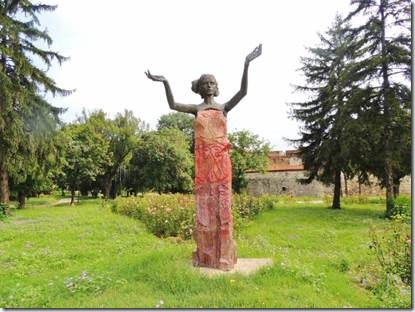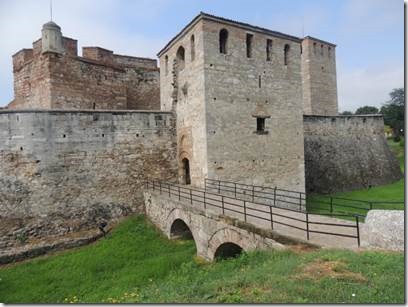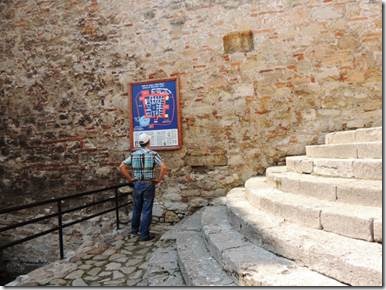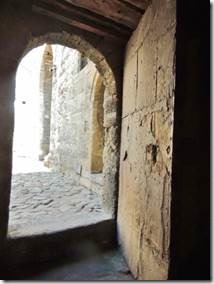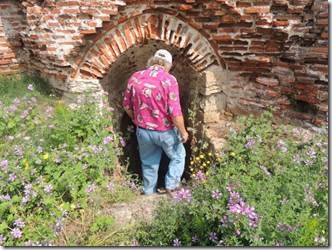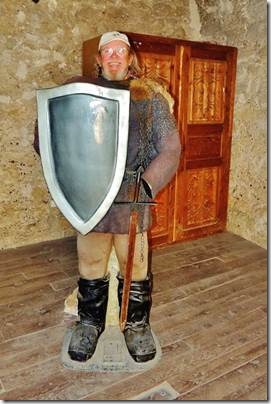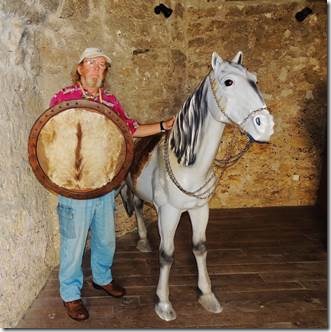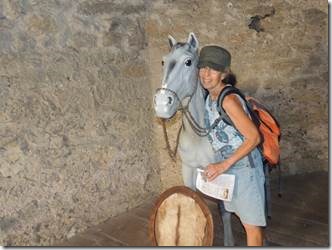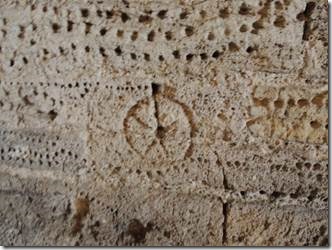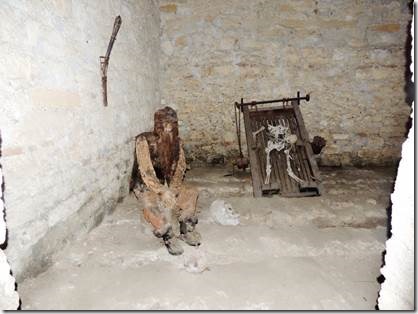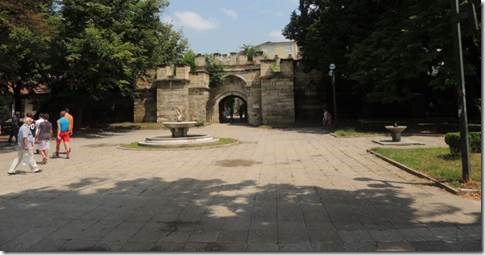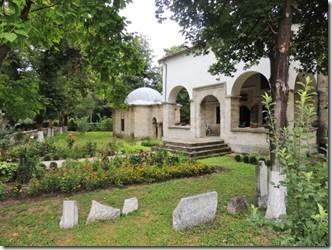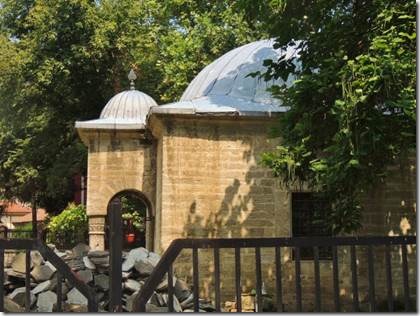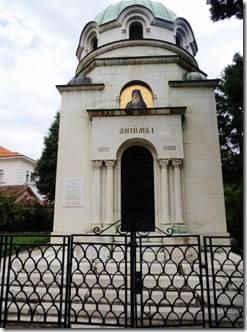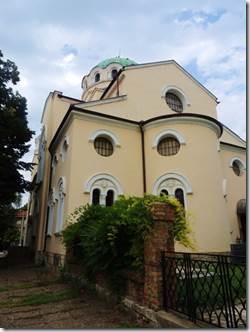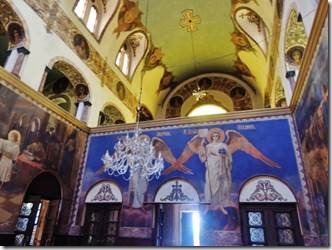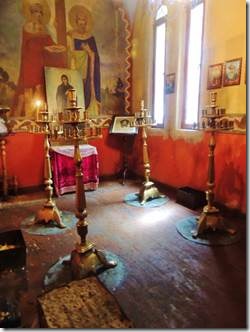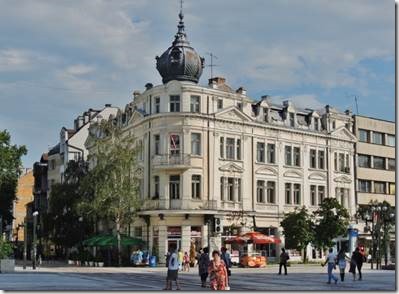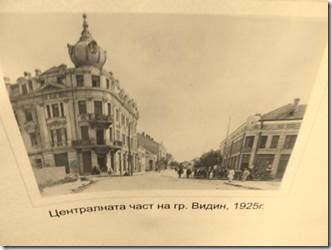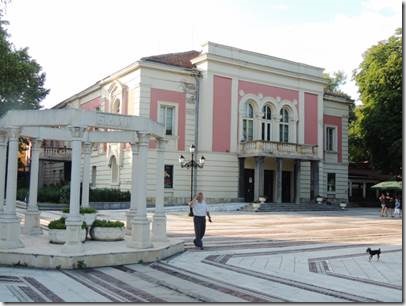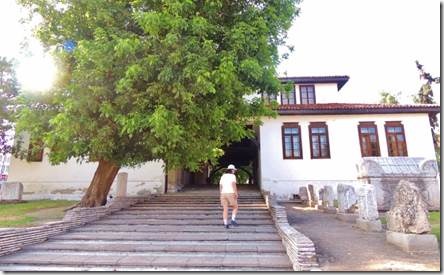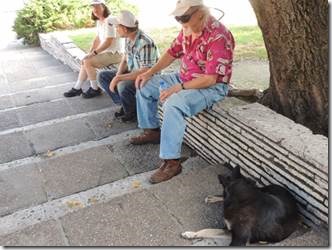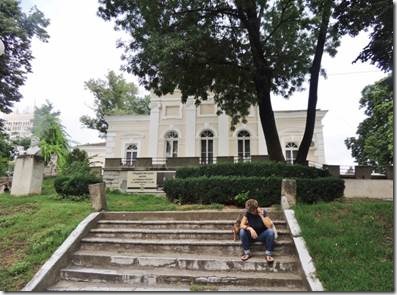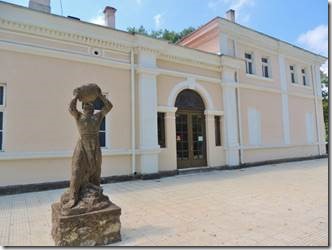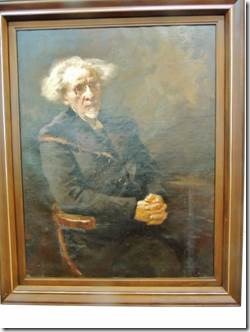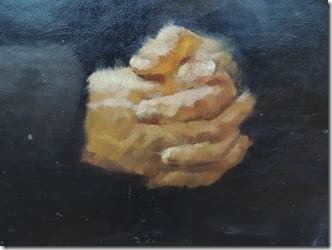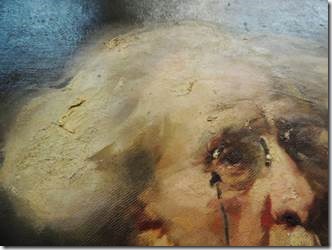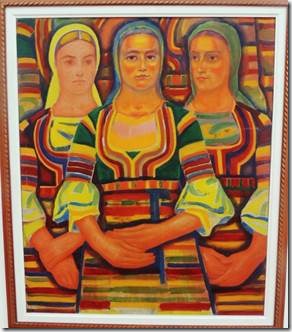Republica Restaurant Barge
Tulcea, Romania
Salut,
We’re really getting close to the end of our passage to the Black Sea. Tonight we’re in Tulcea, the largest town of the Delta. This email is part 2 of Vidin, Bulgaria so many stops back now that I’m never sure what country I’m in after a bit. As I said in the first email, I really liked Vidin.
Ru
Historic Vidin
“Vidin was conclusively liberated from Ottoman authority on March 25/April 6, 1878,” says my Municipality of Vidin Monuments of Culture Guide.
A bit of Bulgarian history…
“The Bulgars, a Central Asian Turkic tribe, merged with the local Slavic inhabitants in the late 7th century to form the first Bulgarian state. In succeeding centuries, Bulgaria struggled with the Byzantine Empire to assert its place in the Balkans, but by the end of the 14th century the country was overrun by the Ottoman Turks. Northern Bulgaria attained autonomy in 1878 and all of Bulgaria became independent from the Ottoman Empire in 1908. Having fought on the losing side in both World Wars, Bulgaria fell within the Soviet sphere of influence and became a People’s Republic in 1946. Communist domination ended in 1990, when Bulgaria held its first multiparty election since World War II and began the contentious process of moving toward political democracy and a market economy while combating inflation, unemployment, corruption, and crime. The country joined NATO in 2004 and the EU in 2007.
Bulgaria, a former Communist country that entered the EU on 1 January 2007, averaged more than 6% annual growth from 2004 to 2008, driven by significant amounts of bank lending, consumption, and foreign direct investment. Successive governments have demonstrated a commitment to economic reforms and responsible fiscal planning, but the global downturn sharply reduced domestic demand, exports, capital inflows, and industrial production. GDP contracted by 5.5% in 2009, and has been slow to recover in the years since. Despite having a favorable investment regime, including low, flat corporate income taxes, significant challenges remain. Corruption in public administration, a weak judiciary, and the presence of organized crime continue to hamper the country’s investment climate and economic prospects. “
|
A rose garden behind the lovely sculpture just near the Baba Vida Fortress. Bulgaria is a major exporter of roses. |
|
“The Babini Vidini Kuli fortress, also known as Baba Vida Fortress is situated on an area of 9.5 decares on the bank of the river Danube, in the northern part of Vidin. The fortress was raised upon the remains of the ancient town of Bononia. The construction of the medieval castle began during the second half of the 10th century, but during the Second Bulgarian Empire (the end of the 12th – 14th century) the basic construction was performed. The last Bulgarian king before the falling of Bulgaria under the Ottoman dominion, Ivan Sratsimir (1324– 1397) had lived in the fortress. According to a legend, Vida had been the eldest daughter of a wealthy Bulgarian boyar. Due to the unsuccessful marriages of her sisters – Kula and Gamza, Vida rejected all of the proposals for marriage, built the castle and remained in it for the rest of her life. During the Ottoman rule, the warehouse premises for food and ammunition and guard-rooms were separated in the fortress. And after the Liberation (1878) the access to it was forbidden because the site was used by the army. The first excavations in the fortress from 1956 to 1962 uncovered remains of the Roman, Byzantine, early Bulgarian, late Bulgarian and Ottoman age. Baba Vida was opened to visitors in 1958 and a museum was arranged in the fortress. In 1964 the medieval castle was declared a monument of culture, having national significance. The fortress is surrounded by a moat, which was sometimes filled with water from the river Danube, and the bridge was mobile. Baba Vida had nine corner and intermediate towers with the walls and the towers ending with loop-holes. The grounds of a chapel from the 13th-14th century were found during excavations in the fortress. At the moment two of the towers are accessible for visiting. There is a prison in the fortress, in which torture devices can be seen. The figures of an executioner and a prisoner with which the tourists often take pictures are attractive. Cannons and gallows are exposed on one of the terraces. Baba Vida is among the most preserved medieval fortification constructions in Bulgaria, which is why it is not accidentally often chosen as a set for shooting movies. The summer theatre of Vidin where concerts, theater performances and other shows are conducted, is also situated in the fortress. Post cards, souvenirs and information materials can be bought for a memory of the fortress. |
|
Lots of stairways up and dark stone spiral stairways down. |
|
Captain Randal in armor with his shield and trusty steed. Who could resist? |
|
We made a guess that the holes were made by the prisoners counting days and maybe even months or years! Pretty gruesome display though the Bulgarian travel website describes it as ‘attractive.” |
|
Stambol Gate “Stronghold walls “Kaleto” “Because of the necessity of additional strengthening for the town of Vidin that after 1718 became a borderline territory for the Ottoman Empire, for a period of 30 years (1690-1720) the so-called “Kale” was constructed – stronghold walls surrounding the town at all sides. They are a semi-circle with a diameter of 1600 meters along Danube river and double stone wall facing the river. A ditch was dug at the side of the shore with depth of 5-6 meters and width of 18 meters, faced with stone and filled with water in the past. “Kaleto” had 9 entrance gates (doors). The preserved equipments today are parts of the stronghold doors, the Northern half of the ditch and small part of the walls. The preserved gates are Florentin gate, Enichar gate, Pazar gate and Stambol gate (the main gate of the Vidin Kale). They are arched passages with guard premises inside the walls. They used to get closed with two-leaf gates of oak girders cased with iron. One could pass above the ditch along wooden bridges as one part of them was mobile. The exit to Danube river was also possible via other 5 doors: Aralak gate, Top gate, Saray gate, Telegraph gate and Syurgyun gate (the first and the last of them are bricked up). The stronghold wall is preserved next to Telegraph gate. After “Kaleto” was constructed Vidin has never been conquered by an enemy during whatever military actions. “Kaleto”, together with the preserved gates (doors) is a cultural monument of national significance.“ |
|
The Osman Pazvantoglu mosque with the arrow instead of the crescent….. Two men were just starting afternoon prayers so I didn’t enter the mosque though they invited me to join when they noticed me looking in. “The town’s heyday was in the 14th century when, under the name of Bdin, it was capital of the principality of the same name, but it fell to the Ottomans in 1396. The Turkish feudal lord Osman Pazvantoglu took it as his own personal fief from 1793-1807. ……..If you visit the town be sure to see the interesting mosque and mausoleum-like library (ca.1800) of Osman Pazvantoglu, who had rebelled against the Sultan. The mosque is built in typical oriental style but instead of the crescent moon that normally tops the dome, here it is an arrow-head – eloquent testimony to the builder’s insubordination.” JPM Danube Guide |
|
“The struggle of the Bulgarians for a church independent from the Greek clergy was crowned with success in 1868. Later on 1872, Antim, the Bishop of Vidin, was elected the first Bulgarian exarch in the second half of the 19th century.” Municipal of Vidin Monuments of Culture booklet The Metropolitan Complex including Saint Nikolai Mirlikiiski Church The full name of the church is “St. Nikolai Miracle Worker”. It was built in 1926 after the design of arch. Kosta Nikolov, who also managed the construction works. The church was erected in the place of an old bell-tower and an extension to the “St. Panteleimon” Church. That extension had been used as “St. Nikola” temple”. /1799/. Today “St. Nikolai” Church is part of the complex including: the “St. Panteleimon” Church/1634/, the residential building of the Metropolitan of Vidin /1924 /, the mausoleum of Antim I /1934 / and the eparchial school /1926 /. It is of the three –nave cross-vault type of churches, with one apse, narthex and towers. Besides a rear gallery for the people, it also has two side galleries. The walls are all painted. http://vidin.bg/?page_id=691&lang=en “The main religion in Bulgaria is Bulgarian Orthodox. There are also Roman Catholics, Muslims, Protestants, Jews etc. Around twelve percent of the people are Muslim. The Eastern Orthodox Church emerged as a result of disagreements between Greek speaking eastern churches and Latin speaking western churches over doctrine and ecclesiastical authority. During the Ottoman rule it was placed under the jurisdiction of the patriarch of Constantinople. However, with the demise of the Ottoman empire many independent churches emerged in eastern Europe. Remaining in communion they retain their independence. “ http://www.bulgarianembassy-london.org/ |
|
Just across from the main square. Happily some things don’t change! |
|
Municipal Theater : Vladimir Trendafilov Drama Theater Vida Charity Theater Society was established in 1879. The first performances were held at the National Cafe in the Bolyarska neighborhood. The Vida Theater was built in 1891 with funds collected by a steering committee. This is the first building in Bulgaria that was built to be used as a theater. Today, the Vidin Drama Theater has an extensive repertoire and has performances two seasons every year. State Puppet Theater (Very sorry not to have seen any performances.) The Vidn Puppet Theater was established in 1976 as a section of the Tsvyat Community Center. In 1980 it became a state theater under the Ministry of Culture. Since 2000, the puppet theater is co-financed by the Municipality of Vidin and the Ministry of Culture. At present, the staff is 24. The actors are 9, with their own director, art studios, technical staff and administration. The performances are mostly for children but there are some for adults as well. 3 to 4 new performances are staged every year. Annually, the theater has about 200 performances in the city and the neighboring communities, as well as all over the country. The actors utilize different systems of puppets but show a consistent interest in the theater of shadows. The Vidin Puppet Theater is the only Bulgarian theater that is a member of the Art for Children and Youth European Association in Amsterdam, the Netherlands. The Vidin Puppet Theater has participated in many national and international meetings and festivals and has been awarded many prizes, such as: first prize of the National Puppet Acacdemy; the Special Award of the Jury at the International Puppet Festival in Botoshani, Romania (1996); the Most Theatrical Team Award at the International Puppet Festival in Subotitsa, Yugoslavia (1997); the award of the Dutch Embassy and the Projects: East West Dutch Foundation at the International Puppet Festival in Pleven (1999 and 2000). The Vidin Puppet Theater has successfully performed in Germany, Austria, Yugoslavia, Mongolia, Croatia, Romania, Hungary and Albania. |
|
Konak or Town Hall Closed when we stopped by.) The top of the building is hidden behind the tree and in the haze. “The building is a unique architectural and cultural monument of local significance. It was built up in the 18th century and served as a (Turkish) police station. Because of the good visibility the central tower part served as a fire-tower. After the Liberation from the Ottomans it was reconstructed and Bulgarian Renaissance architecture elements were introduced. It has been a museum since 1956. The exposition traces back the history of the Vidin region from the remote past to the Liberation. The foundations of the museum activity in Vidin region were laid in 1910 when the Archaeological Society was established and the first museum collection was arranged. When the wars from the mid 20-ties of the 20th century were over Bononia Archaeological Society activated its collecting activity and under the guidance of the teacher Vasil Atanasov arranged an exposition of numismatic materials and Bulgarian embroideries in the old Turkish post-office building. Vidin history museum has strengthened its positions in the national museum network by its successfully arranged museum expositions, structuring of the departments and achievements in the science and research domain. http://museum-vidin.domino.bg/eng/index2.htm Town Hall Stairs As soon as we arrived in the town center, this dog joined us for our entire walk. Thankfully it didn’t follow us back to the boat because it was so sweet I would have had a hard time not getting “too involved.” |
|
Art Museum, a 5 minute walk from DoraMac so I took myself one day. When I got there, the posted hours said it would be open but it was closed. I looked around for a bit and peered into the window and then started to walk away. A man called to me and then walked over and unlocked the door and flipped on the lights. It was really sad. The building smelled musty and the floor was uneven as if it had been flooded and dried badly. I found maybe 100 paintings on the walls and didn’t see any way to go anyplace other than the first floor. No one came to check on me and the signage was all in Bulgarian. So my experience definitely doesn’t match the description below. They need to have someone from the wonderful art museum in Silistra come and help them. But I’m sure, like the Synagogue, it’s partly a matter of money. And I believe Silistra is a good deal larger and supports 2 “5 star” hotels. It definitely looked to have more money. |
|
The Regional Art Gallery in town of Vidin was founded in 1962 by the initiative of the local cultural and public figure Angel Budev. The current name Nikola Petrov is since 1976, when was the 60-year anniversary of the death of the great Vidin artist – Nikola Petrov. The gallery is housed in a building dating-back to 1892 (former Military Club), which has very beautiful and exquisite architecture and is located near the Danube Park. In the courtyard of the gallery are placed several beautiful stone sculptures and a monument of Nikola Petrov, whose name bears the gallery. In the Art gallery Nikola Petrov are exposed more than 1300 works of famous Bulgarian and foreign artists, arranged in three specialized divisions: Graphics, Painting and Sculpture. Among the most famous Bulgarian artists are Zlatyu Boyadjiev, Ivan Mrkvicka, Vladimir Dimitrov – Maystora, Nikola Petrov, Sirak Skitnik, Svetlin Rusev and others. Besides its permanent exhibition the gallery houses temporary exhibitions from Bulgaria and abroad. http://visit.guide-bulgaria.com/a/573/art_gallery_nikola_petrov.htm I don’t know the artist or the subject but it seemed so life-like and the hands seemed 3 dimensional. But it looks as if the canvas is deteriorating. I liked this painting too and a couple others. |

